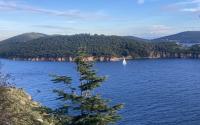19 July 2007Phil McKenna
Ice melt from small glaciers and ice caps will be the dominant cause of sea-level rise this century, according to new research. Scientists have previously suggested that the ice sheets of Antarctica and Greenland would be most responsible for rises as the Earth warms, as they hold the overwhelming majority of the world's frozen water.
Now an international team led by Mark Meier at the University of Colorado in Boulder, US, has found that glacial melt and the "calving" of icebergs into the ocean will account for 60% of all sea-level rise attributed to melting ice (Science, DOI: 10.1126/science.1143906. That is equivalent to an estimated 10 to 25 centimetre rise by 2100.
This calculation does not include the expansion of warming ocean water, which could double the estimate, says Meier.
The findings are surprising as glaciers and ice caps – smaller ice sheets generally covering a mountainous area – contain just 1% of the water found in ice sheets. Yet despite their relatively small size, glaciers contain enough water to raise sea levels by nearly a metre if they were to melt away entirely.
IPCC 'underestimation'
"We think the International Panel on Climate Change substantially underestimated the contribution of small glaciers and ice caps, and may have overestimated the contribution of the Greenland ice sheet," says Meier, of a comprehensive IPCC report on the impacts of climate change (PDF), published in early 2007.
The report predicted that sea levels worldwide will most probably rise between 21 and 47 cm by 2100, taking the averages of the six scenarios considered. Using the new figures on small glaciers, Meier calculates the rise to be between 27 and 97 cm.
"This is an appreciable adjustment," Meier says. He notes that more than 100 million people live within one meter of the current sea level.
Glaciers and ice caps, according to Meier, are particularly susceptible to large decreases in size because "they're thinner, warmer, and more delicate" than large ice sheets. (See time-lapse video of the Columbia Glacier, Alaska, right.)
Retreat rate
Meier's team came to their conclusion by analysing satellite, aircraft, and ground-based data from glaciers and ice caps worldwide, as well as the ice sheets of Greenland and Antarctica. They calculated present and future rates of ice loss based on figures for snow and ice accumulation, glacier size, thickness, mass, and rates of thinning and retreat.
They then used a mathematical "scaling" process to derive estimates for more glaciers in remote areas, where data is scarce. These estimates included volume and thickness, and factored in data like altitude, climate, and geography.
"What they are trying to study is very difficult because of gaps in the data," says William Harrison of the University of Alaska in Fairbanks.
According to Harrison, less than half of present day ice cover in Alaska has been mapped to see how it compares to comprehensive mapping surveys done in the 1950s and 1960s. "I think they've done an excellent job of recognizing that uncertainty and trying to fill in those gaps," he says.
Martin Sharp, a glaciologist at the University of Alberta in Edmonton, Canada, says the study reduces some of the uncertainties that were associated with sea-level rise. But, he takes issue with claims made in the study that glacier and ice cap contributions will continue to be more important relative to ice sheet contributions after 2100.
"We have no real understanding of the likely dynamic responses of the large ice sheets to ongoing warming," Sharp says. "They could be right, but they could equally well be wrong."






